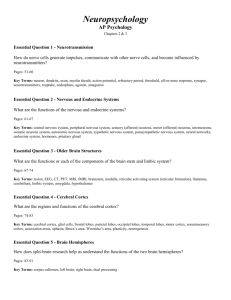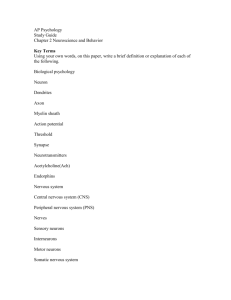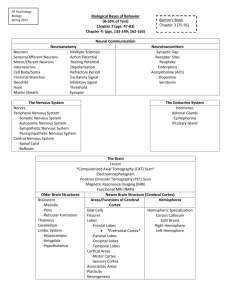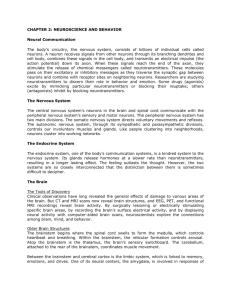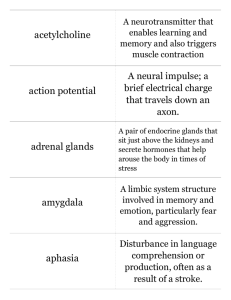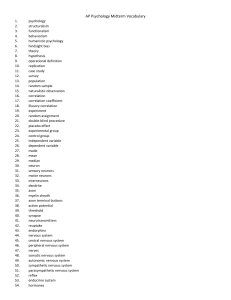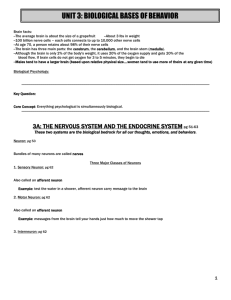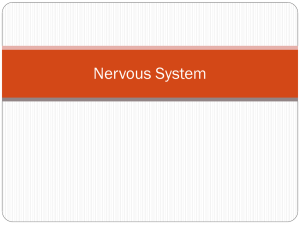INTRODUCTION TO PSYCHOLOGY
advertisement
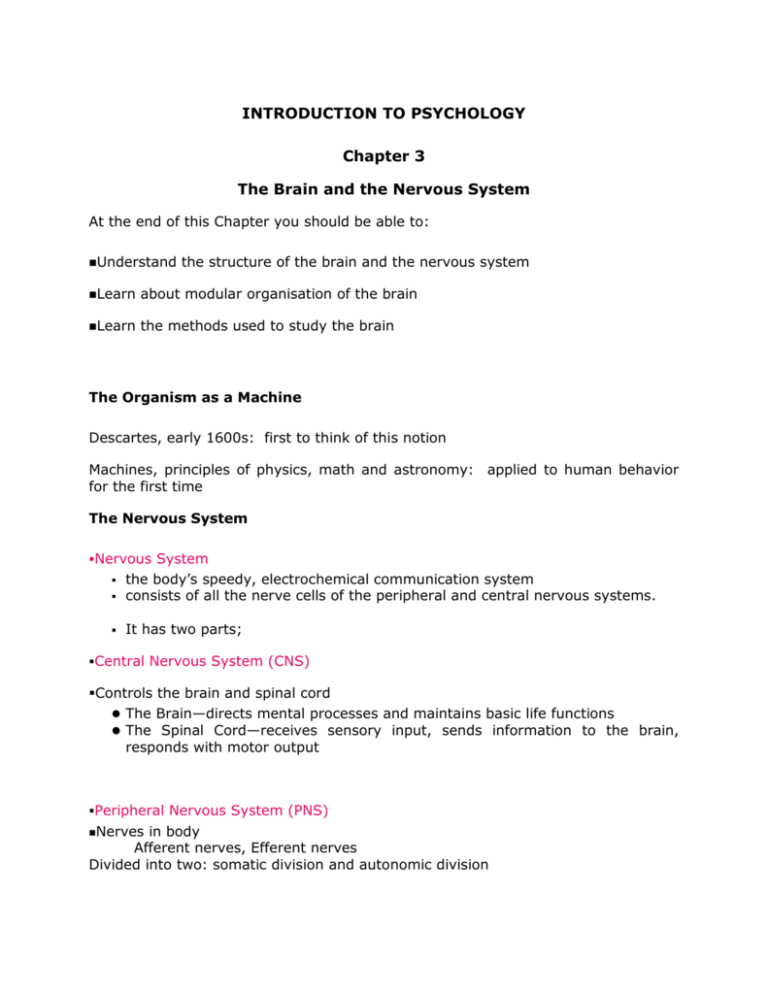
INTRODUCTION TO PSYCHOLOGY Chapter 3 The Brain and the Nervous System At the end of this Chapter you should be able to: Understand the structure of the brain and the nervous system Learn about modular organisation of the brain Learn the methods used to study the brain The Organism as a Machine Descartes, early 1600s: first to think of this notion Machines, principles of physics, math and astronomy: applied to human behavior for the first time The Nervous System Nervous System the body’s speedy, electrochemical communication system consists of all the nerve cells of the peripheral and central nervous systems. It has two parts; Central Nervous System (CNS) Controls the brain and spinal cord The Brain—directs mental processes and maintains basic life functions The Spinal Cord—receives sensory input, sends information to the brain, responds with motor output Peripheral Nervous System (PNS) Nerves in body Afferent nerves, Efferent nerves Divided into two: somatic division and autonomic division How the Nervous System is Studied Field: NEUROSCIENCE Study of: nature, functions, origins of the nervous system: multidisciplinary; Begins with studying cells of the nervous system Neurons - up to one billion cells - inter-connections up to 50,000 per neuron Studying the Nervous System Clinical observation Phineas Gage: frontal lobe damage Neuropsychology what happens to behavior when brain structures are damaged Experimental techniques Lesioning brain structures, observing consequences Transcranial magnetic stimulation: temporary loss of brain function in isolated areas near surface of brain (just under scalp) Neuroimaging techniques: To examine structures and functioning of brain Computerized Tomography (CT): - Images created from multiple x-ray images of brain. Magnetic resonance imaging (MRI), Functional MRI (fMRI): - Responses of cell nuclei to magnetic current differ - Different types of cell nuclei “resonate” at different frequencies; these differences mapped to create pictures of brain structure; - Can examine behavior of brain in “real time” (fMRI). Electroencephalography (EEG): - Detects electrical current at surface of brain (scalp) - Wave forms/patterns vary with brain activity Caution: Correlation and Causation Neuroimaging (NI) techniques: correlational in nature Conclusions to be drawn from data collected using solely correlational techniques: not always reliable Brain damage + NI techniques: lead to better understanding of relationship of brain structure to function Double dissociation: one function preserved, another is damaged: different structures necessary for different brain functions Brain Structure Hindbrain Controls many functions key to survival, including keeping airway clear, heart beat, breathing, reflexes, sleep, respiration, balance Midbrain Coordinates motion, relays information to other sites; targeting auditory and visual stimuli, regulating body temperature Forebrain Cortical and sub-cortical structures; intelligent adaptive behavior. Brain Structure Cortex 3 mm. thick 80% of total brain volume Convoluted (folded, wrinkled) structure enables more tissue to fit The cortex provides flexibility in behavior Divided into 2 hemispheres and 4 paired lobes: frontal, temporal, occipital, parietal Localization: Each structure has a somewhat different set of tasks and skills Multiple structures needed to perform complex tasks The Brain’s Higher Functions The Cerebral Cortex—the bumpy, convoluted area on the outside of the two cerebral hemispheres that regulates most complex behavior, including receiving sensations, motor control and higher mental processes (i.e., thinking, personality, emotion, memory, motivation, creativity, self-awareness, reasoning, etc.) Cerebral Cortex—Four Lobes Frontal Lobes—receive and coordinate messages from other lobes as well as motor control, speech and higher functions Parietal Lobes—receives information about pressure, pain, touch and temperature Temporal Lobes—hearing, language comprehension, memory and some emotional control Occipital Lobes—vision and visual perception Lateralization The Cerebral Cortex is divided into two hemispheres (left and right) connected by the Corpus Collosum Each hemisphere receives and sends information to the opposite side of the body Each hemisphere also specializes in certain functions LEFT and Right tightly coordinated -Both necessary for efficient and normal brain function Each hemisphere has some special abilities: The Left Hemisphere (or Left Brain) Language Functions (speaking, reading, writing, and understanding language) Analytical Functions (mathematics, physical sciences) Right-hand touch The Right Hemisphere (or Right Brain) Non-verbal abilities (music, art, perceptual and spatial manipulation, facial recognition) Some language comprehension Left-hand touch The Cerebral Cortex Broca’s Area an area of the left frontal lobe that directs the muscle movements involved in speech Wernicke’s Area an area of the left temporal lobe involved in language comprehension and expression Specialization and Integration Cortical Damage can cause Disorders of... ACTION: ex: Apraxia – inability to initiate or carry out learned complex (2+ steps) motor action PERCEPTION and ATTENTION: ex: Agnosia – inability to identify familiar objects (persons, sounds, shapes or smells) using the affected sense Plasticity Definition: “Subject to alteration” Historically, nervous system deemed NOT plastic New evidence: Neurons can change, form new connections with other neurons. As a result, the brain itself can entirely change. Should all psychological questions have biological answers? In many cases, a biological answer to a sociological question: Not practical Not helpful Not possible! Many other levels of analysis need to be applied in order to answer many questions about human behavior
